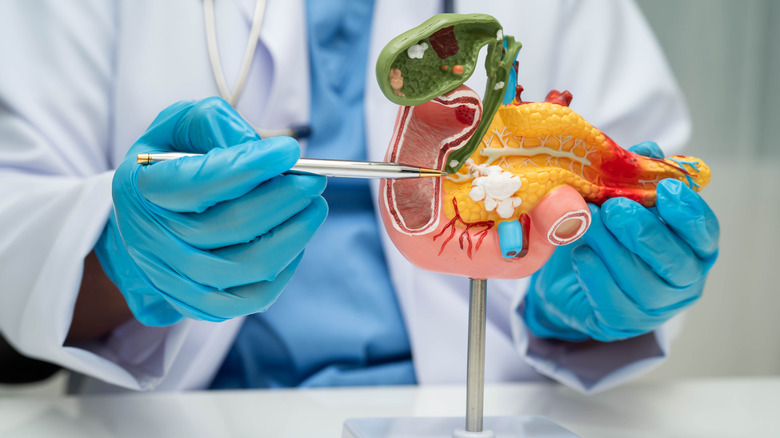The Most Painful Diseases To Die From, Hands Down
Death is something that all of us are going to have to face at some point or another. And, to that end, most people are accepting of that fact. Studies show that more than half of people profiled are not afraid of death, although 42% of people do fear death at least somewhat (per Statista). Additionally, one in four Americans says that they don't fear death at all.
However, although the fear of death may not be all-encompassing, it can affect people to some degree or another. According to a 2017 study in Frontiers in Medicine, death anxiety, or thanatophobia, often centers less on death itself and more on the process of dying. Findings revealed that nearly four out of five people were particularly afraid of dying a painful death. However, a 2020 study in BMC Palliative Care showed that less than one in every five patients experienced severe pain in the last month of life. That said, these particular diseases can make dying an especially painful experience.
Pancreatic cancer
The tumors from pancreatic cancer can have an impact on the nerves near the pancreas. Additionally, part of the small intestine known as the duodenum can be blocked by tumors, which can result in pain and discomfort. Fluid buildup in the stomach, called ascites, can also occur, which can cause pain.
In addition, although less common, pancreatic cancer can also spread to the patient's bones. This can cause a host of painful issues, including bone pain or broken bones during normal activities. The cancer can also compress the spinal cord, which can result in back pain and numbness in the lower extremities. In more serious cases, this compression can also result in bladder and bowel incontinence. Bone cells can also be damaged by pancreatic cancer, which can cause calcium levels in the blood to be higher than normal. This can lead to a number of unpleasant symptoms, such as aches and pains, excessive thirst, and kidney failure.
Osteosarcoma
Bone cancer can be painful from the start, as the tumor's growth can begin to press down on the nerves and blood vessels laced throughout the bone's layers. This can not only cause pain, but it can inhibit movement as well. (Here are the warning signs of bone cancer you shouldn't ignore.) Additionally, the American Cancer Society reports that pain around the area of the tumor can be worse at different times, such as at night or when walking. Tumors can also weaken bones, leading to sudden and painful breaks.
A 2021 study published in the Journal of Advanced Research shows that the erosion of bone from certain cancers, such as Ewing's sarcoma, can be significant enough that it looks as though the bone has been eaten away. The tumor growth can also activate immune cells in the spinal cord, which can release inflammatory substances that heighten one's sensitivity to pain. This is a process known as central sensitization; over time, it can cause even normal movements to become painful.
End-stage ALS
Amyotrophic lateral sclerosis, or ALS, is a progressive disease that weakens the nerve cells in both the brain and the spinal cord, causing the muscles to weaken over time. (Read how ALS is treated.) As the disease progresses, it becomes harder and harder to walk, move, speak, or even breathe. According to the University of Virginia, patients with ALS can experience what is known as "locked-in" syndrome. Patients at this stage are fully alert and conscious, but can't move at all.
This end stage of ALS can present a number of difficulties, both for patients and caregivers. According to a 2002 study in Neurology, caregivers treating patients with end-stage ALS reported that more than half of ALS patients at the end of their lives reported experiencing dyspnea, or difficulty breathing. They also reported frequent and severe pain. In addition to pain, 48% of caregivers noted that patients at this stage also experienced discomfort of one kind or another.
Gallbladder cancer
People who have gallbladder cancer can experience pain in a number of different ways. Generally, it can be an aching pain in the upper right area of the belly. However, if the bile ducts are blocked by gallstones, that pain can feel sharp. As the cancer progresses to more and more advanced stages, growing cancer cells can cause the organs to stretch or even fully block the bile ducts, leading to even more severe pain.
Gallbladder cancer pain can stem from cancer cells blocking the celiac plexus, a cluster of nerves located near the liver. When the celiac plexus is impacted by cancer growth, the pain can present as sharp, stabbing, cramping, or squeezing. If this happens, your doctor can prescribe a procedure known as a celiac plexus block, which numbs the nerves in the area, helping to manage pain. (This is the sort of diet that you should be following if you have gallstones.)
Necrotizing fasciitis
A flesh-eating bacterial infection, necrotizing fasciitis is a rare but serious condition that, if left untreated, can be fatal. According to the Centers for Disease Control and Prevention, the condition can lead to such life-threatening problems as shock, sepsis, and organ failure. It can also lead to limb amputation as doctors attempt to stave off death by removing infected body parts. Even with treatment, one in five people who contract necrotizing fasciitis do not survive.
People suffering from necrotizing fasciitis can experience a number of unpleasant symptoms, including dehydration, diarrhea, nausea, and dizziness. As the disease progresses, patients can experience swelling of the limbs, purple rashes breaking out around the infected area, and flaking and peeling of the skin as tissue death occurs. According to a 2017 report published in the British Medical Journal, necrotizing fasciitis can lead to a condition known as toxic shock syndrome, a rare but serious condition marked by multiorgan failure that is fatal in 70% of cases.
Huntington's disease
Although rare, Huntington's disease is a genetic condition that causes decay in the nerve cells of the brain. It can cause involuntary muscle movements, such as jerking or twitching, as well as muscle rigidity. The disease can also cause mental health and cognitive issues, including a lack of impulse control, irritability, and suicidal ideation.
These effects of Huntington's disease mean that patients who suffer from the condition can often be in a lot of pain. However, according to Huntington's Disease News, pain is often an overlooked symptom. Experts have said that four out of five Huntington's disease patients in nursing homes and half of all at-home patients are "in pain of some kind." This pain can include headaches, abdominal pain, and fractures from uncontrolled movements. And, due to the mental effects that can stem from Huntington's disease, many patients do not do anything to manage or treat their pain, which means that they are often suffering constantly and not understanding why. Sadly, at present, there is no cure for Huntington's disease.
Esophageal cancer
Esophageal cancer can sometimes present in its initial stages with pain. Patients can feel pain when swallowing, known as odynophagia. They can also experience difficulty swallowing, which can become progressively worse as the cancer grows. In addition, patients who are suffering from esophageal cancer can have heartburn, pain and pressure in the chest, and chronic cough and hoarseness.
As the disease progresses, pain and suffering can become much worse. Patients can experience a host of painful symptoms, including bone and joint pain, esophageal bleeding, sore throat, and difficulty speaking. Additionally, according to Dr. Belal Bin Asaf, at the end stages of esophageal cancer, the tumors can invade other organs, such as the lungs and liver, and even the bones. This can cause extreme pain throughout the body. As such, caregivers looking after a patient suffering from end-stage cancer of the esophagus should have pain management strategies in place.
Ebola
Ebola virus is a rare but very serious disease that, according to the World Health Organization, is fatal in 50% of cases. In past outbreaks, the mortality rate has been as high as 90%. Transmitted via blood, bodily fluids, or by touching contaminated surfaces, the disease presents itself suddenly with fever, muscle pain, and headaches. According to the Centers for Disease Control and Prevention, these are known as the "dry" symptoms of the virus. As the disease progresses, it enters what is called the "wet" stage. This stage is marked by watery diarrhea, vomiting, and extreme abdominal pain.
As the virus enters its late stages, these so-called "wet' symptoms can become even more severe. They can include bloody vomit or vomiting up a substance that looks like coffee grounds, bloody stools, and rashes and blood blotches under the skin. (Here's what's really happening to your body when you vomit.) Patients can also experience inflammation of the brain, seizures, organ failure, and shock.
Rabies
Although rare in the U.S., rabies is almost guaranteed to be fatal by the time it reaches the central nervous system. Rabies is usually transmitted through the saliva of warm-blooded animals such as skunks, foxes, raccoons, and bats. It can also be carried by dogs and cats. In the United States, bat bites are the most common cause of rabies, with the bite marks often being so small that people sometimes don't even know they've been bitten until symptoms start. (This is the first thing you should do after a bat bite.)
At the outset, rabies can present like the flu, with a high fever, sore throat, nausea, and vomiting. However, as it progresses, the symptoms become more severe and terrifying. They include aggression, confusion, paralysis, hallucinations, nightmares, and convulsions. Additionally, the disease causes intense spasms in the throat, which makes drinking impossible. By the end, even the thought of drinking can trigger these spasms, giving the impression that the patient is actually afraid of water.









